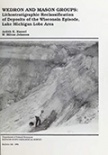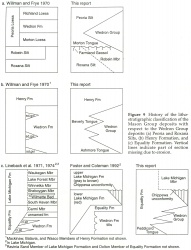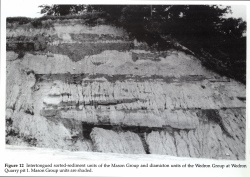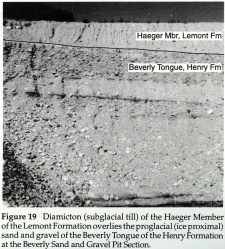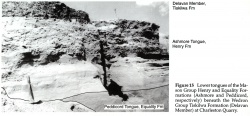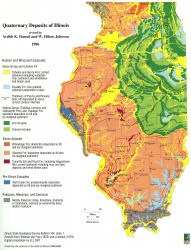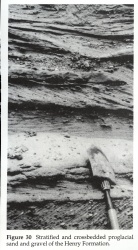Historical:Henry Formation
Lithostratigraphy: Mason Group >>Henry Formation
Chronostratigraphy: Cenozoic Erathem >>Quaternary System >>Pleistocene Series
Authors
Ardith K. Hansel and W. Hilton Johnson
Name
Original description
Henry Formation (Willman and Frye 1970).
Derivation
Henry, a village in Marshall County, central Illinois.
History/background
The Henry Formation was defined by Willman and Frye (1970) as glacial outwash, predominantly sand and gravel, that occurs above the Sangamon Soil and is either at the surface or overlain by the Richland Loess or post-Wedron formations; it was classified with the Wisconsinan Stage. Willman and Frye included similar deposits that underlie or intertongue with till of the Winnebago and Wedron Formations as sand and gravel facies of those formations; they separated them from the Henry Formation by arbitrary vertical boundaries (fig. 9b). They differentiated three members in the Henry Formation, the Batavia, Mackinaw, and Wasco.
Like the formation, these members are lithogenetic units. They were defined on the basis of genesis and morphology; yet, because the three members represent different sedimentary environments, they generally have different lithologic characteristics as well. The Batavia Member, defined as an upland unit deposited mostly along the fronts of moraines (outwash plains), consists of deposits that vary more in degree of coarseness, both vertically and laterally, over shorter distances than do deposits of the Mackinaw Member, which was defined as outwash deposited in valleys (valley trains). Sand and gravel of the Mackinaw Member, generally sandy gravel or pebbly sand, is more evenly bedded and more uniform in texture than that of the Batavia Member or the Wasco Member, which consists of ice-contact sand and gravel in kames, eskers, and deltas. Deposits of the Wasco Member are the most variable of the three members in grain size, sorting, bedding, and structure. The three members tend to grade into and interfinger with each other. For example, where outwash plains converge into the valleys, the Batavia Member grades into the Mackinaw Member, whereas deposits of pitted outwash plains of the Batavia Member may grade into ice-contact deposits of the Wasco Member in the up-ice direction.
We redescribe the Henry Formation in two ways: (1) on the basis of lithostratigraphic rather than lithogenetic criteria, and (2) as a lithostratigraphic unit that intertongues with the diamicton units of the Wedron Group (i. e., lateral extensions of the unit interfingering with diamicton units of the Wedron Group are classified as tongues of the Henry Formation rather than vertical facies within diamicton units, separated from the Henry Formation by vertical boundaries; fig. 9b). As redescribed, the Henry Formation consists of fine to coarse grained, well to poorly stratified sediment of predominantly sand and gravel that overlies the Sangamon Geosol and interfingers with the Wedron Group diamicton units and other Mason Group sorted-sediment formations. In this revision, more sediment is classified as the Henry Formation than previously. Included are not only tongues of ourwash sand and gravel interfingered with other units, but also sand and gravel formerly classified as the Parkland Sand, the Dolton Member of the Equality Formation, and the Ravinia Sand Member of the Lake Michigan Formation.
Two tongues are formalized in the Henry Formation. The Ashmore Tongue (fig. 12) occurs stratigraphically below diamicton of the Tiskilwa Formation and above the Peddicord Tongue of the Equality Formation, the Morton Tongue of the Peoria Silt, or the Robein Member of the Roxana Silt. The Beverly Tongue (fig. 19) occurs stratigraphically below the Haeger Member of the Lemont Formation and above other units of the Wedron or tongues of the Equality Formation. The lithogenetic-based Batavia, Mackinaw, and Wasco Members of the Henry Formation defined by Willman and Frye (1970) are not retained as formal lithostratigraphic units; instead, the names are retained for informal sedimentary facies that are helpful in understanding glacial history and predicting relationships among materials. The former Dolton Member of the Equality Formation and Ravinia Sand Member of the Lake Michigan Formation are also treated herein as an informal facies (nearshore lacustrine) of the Henry Formation. Likewise, most of the former Parkland Sand (well sorted, fine to medium grained sand that generally occurs near the surface in dunes or sheetlike deposits) is treated as an informal facies (eolian) of the Henry Formation. Other informal units will be designated as the need arises in regional and local studies (e. g., designations to separate Haeger-related Henry Formation from Tiskilwa-related Henry Formation in those places where the two occur together in the same map area). Many of these informal facies are meaningful map units.
Type section
A gravel pit along Illinois Highway 29, 2 miles (3.2 km) north of Henry, Illinois; no longer exposed.
Reference section
Beverly Sand and Gravel Pit (fig. 19) and Wedron and Charleston Quarry Sections; both good for intertonguing relationship with the Wedron Group (figs. 12, 15).
Stratigraphic relationships
The Henry Formation consists of stratified sand and gravel that occurs above the Sangamon Geosol. It intertongues with other formations of the Mason Group, particularly the Equality Formation, and the diamicton formations of the Wedron Group. In major river valleys, it is commonly overlain by the Cahokia Formation. Two tongues of the Henry Formation are formally recognized, the Ashmore Tongue (figs. 12, 15), which extends beneath the Delavan Member or the undivided Tiskilwa Formation, and the Beverly Tongue (fig. 19), which extends beneath the Haeger Member of the Lemont Formation.
The coarse, stratified sediment of the Henry Formation is generally readily distinguishable from the diamicton units of the Wedron Group and Glasford and Winnebago Formations, but sand and gravel lenses that occur within the diamicton units could be mistaken for tongues of the Henry Formation, particularly in the subsurface. Sand and gravel lenses within the diamicton units are generally thinner and less continuous than tongues of the Henry Formation, which occupy distinct stratigraphic positions and can be traced regionally. Although some contacts are gradational and interfingered, the Henry Formation is generally distinct from other sorted-sediment formations of the Mason Group. It may be similar to sand and gravel of the Pearl Formation, but the two units can be distinguished where the Sangamon Geosol is developed in the top of the Pearl Formation. Where the Henry Formation is overlain by silt, sand, and gravel of the Cahokia Formation, the contact between the two units may be gradational; however, the Cahokia Formation is commonly finer grained, and it does not intertongue with the diamicton units of the Wedron Group as does the Henry Formation.
Extent and thickness
The Henry Formation or correlative sediment in adjacent states is present in nearly all the counties that were inundated by the Lake Michigan Lobe during the Michigan Subepisode, but its distribution is discontinuous and extends beyond the glacier margin (plate 1). It most commonly occurs as (1) relatively thin sheetlike deposits wedging out in the up-ice direction beneath diamicton formations and thinning in the down-ice direction away from moraine fronts, (2) ribbonlike deposits along the major drainageways leading away from the moraines and inset in older deposits of both glacial and nonglacial origins, (3) ribbonlike and fanlike deposits along the margins of former or modern lakes, and (4) moundlike and sheetlike deposits around the margin of modern and ancient lakes and on terraces and upland surfaces in and adjacent to the major valleys. The Henry Formation is less commonly found in esker and kame deposits in the Wedron Group area in Illinois. Except where later erosion removed them, the Henry Formation deposits discussed above commonly connect with each other and/or with the fine grained sediment of the Peoria Silt and Equality Formation. The Henry Formation varies considerably in thickness, ranging from more than 65 meters (213 ft) in some of the major valleys to less than 1 meter (3.3 ft) in fans and aprons along moraine fronts or in the subsurface between diamicton units; laterally equivalent units in Indiana and Michigan are even thicker. The sand and gravel resources mapped in northeastern Illinois by Masters (1978) are predominantly of the Henry Formation.
Lithology
The Henry Formation consists predominantly of stratified sand and gravel (fig. 30) that is similar in lithology to the sand and gravel fractions of diamicton units of the Wedron Group. Lenses of silt, clay, organic debris, wood, and shells occur locally in the sand and gravel. The dominant pebble lithology is Paleozoic carbonate similar to that of bedrock in northeastern Illinois, southeastern Wisconsin, and the Lake Michigan basin, but Paleozoic sandstone and shale, as well as igneous and metamorphic rock, are also common. Considerable lateral and vertical variation is present in grain size, sorting, bedding, and structure of deposits within the formation.
The Ashmore Tongue of the Henry Formation is lithologically similar in pebble and carbonate compositions to diamicton of the Tiskilwa Formation, whereas the Beverly Tongue is lithologically similar to diamicton of the Haeger Member of the Lemont Formation.
Contacts
Lower boundary: the contact with tongues of the Wedron Group, Peoria Silt, Equality Formation, and Roxana Silt, or the Loveland Silt, Pearl, Glasford, and Winnebago Formations, or older units. Upper boundary: the contact with the Wedron Group, Peoria Silt, and Equality Formation, or postglacial units, particularly the Cahokia Formation and Grayslake Peat.
Age and correlation
Most of the Henry Formation was deposited during the Wisconsin Episode, predominantly during the Michigan Subepisode between about 26,000 and 11,000 radiocarbon years ago (appendix B2). Some of the Dolton, Ravinia, and Parkland facies are much younger, however, and date up to modern times (Hudson Episode). The Henry Formation correlates with part of the Atherton and Martinsville Formations in Indiana (Wayne 1963) and unnamed units in Wisconsin, Iowa, Missouri, and Michigan.
Environments of deposition
The Henry Formation is interpreted to be (1) outwash deposited adjacent to or leading away from the glacier, (2) nearshore sand and gravel deposited in beaches, spits, bars, and deltas in glacial and postglacial lakes, and (3) eolian sand derived from glaciofluvial, fluvial, and nearshore lake sediments deposited in dunes and sheets on and adjacent to those sediments.
Remarks
Redescribed unit. Formation redescribed to remove lithogenetic concepts from its definition and recognized as intertonguing with diamicton units of the Wedron Group, as well as with other sorted-sediment units of the Mason Group.
References
MASTERS, J. M., 1978, Sand and Gravel and Peat Resources in Northeastern Illinois: Illinois State Geological Survey Circular 503, 11 p.
WAYNE, W. J., 1963, Pleistocene Formations of Indiana: Indiana Geological Survey Bulletin 25, 85 p.
WILLMAN, H. B., and J. C. FRYE, 1970, Pleistocene Stratigraphy of Illinois: Illinois State Geological Survey Bulletin 94, 204 p.
ISGS Codes
| Stratigraphic Code | Geo Unit Designation |
|---|---|
